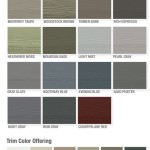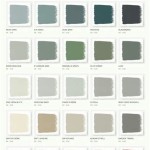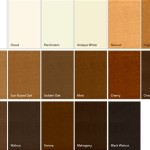How To Choose The Right Paint Color For Your Bedroom
Selecting the appropriate paint color for a bedroom is a significant decision that impacts the overall ambiance and psychological effect of the space. The bedroom is typically considered a sanctuary, a place for relaxation and rejuvenation. Therefore, choosing a color that promotes these feelings is crucial. This article will explore key considerations and provide guidance for navigating the selection process, ensuring the chosen color effectively contributes to a calming and aesthetically pleasing environment.
The perceived color of a room is not solely determined by the paint itself. Elements such as natural light, artificial lighting, existing furniture, and architectural details all play a role in how a color is ultimately perceived. Therefore, a comprehensive assessment of the room's attributes is a necessary precursor to the color selection process.
Understanding the Psychology of Color
Color psychology explores how different colors affect human emotions and behaviors. While individual responses may vary, certain color associations are generally recognized and can be leveraged when choosing a bedroom paint color. Understanding these associations can aid in creating the desired atmosphere.
Blue, for example, is often associated with tranquility and calmness. Lighter shades of blue can create a serene and airy feel, making it a popular choice for bedrooms aimed at promoting relaxation and sleep. However, darker shades of blue, while sophisticated, can sometimes feel cold or melancholic. The specific shade must be carefully considered in relation to the room's lighting and other design elements.
Green, similarly, is associated with nature, balance, and harmony. It can evoke feelings of peace and rejuvenation. Soft, muted greens are particularly well-suited for bedrooms, creating a restful and inviting space. Brighter greens can be stimulating, so they should be used sparingly or in combination with more calming hues.
Purple, often associated with royalty and luxury, can also be calming in its lighter shades, such as lavender. Lavender promotes relaxation and can be particularly effective in creating a soothing bedroom environment. Darker purples, like eggplant, can add drama and sophistication but should be used with caution as they can be overwhelming in a small or poorly lit space.
Gray is a versatile neutral that can provide a sophisticated and calming backdrop. It works well with a variety of other colors and styles. Different shades of gray can evoke different feelings; lighter grays tend to feel more airy and modern, while darker grays can create a cozy and intimate atmosphere. The undertones of gray are crucial to consider, as some grays have blue, green, or even purple undertones that can affect the overall feel of the room.
White, while often perceived as a blank canvas, can be a powerful color choice for a bedroom. It creates a sense of spaciousness and purity. However, it's important to choose the right shade of white, as some can feel sterile or cold. Warmer whites, with subtle yellow or beige undertones, can create a more inviting and comfortable space.
Warm colors like red, orange, and yellow are generally considered more stimulating and energetic. While they may be appropriate for other areas of the home, they are typically not recommended for bedrooms designed for relaxation. However, muted or pastel versions of these colors can be used sparingly to add warmth and personality to a bedroom, especially when balanced with cooler tones.
Assessing the Room's Lighting and Existing Elements
The way light interacts with paint color is a critical factor in determining how the color will appear in the bedroom. Natural light, artificial light, and the direction the room faces all influence the perceived color.
Rooms that receive a lot of natural light, particularly southern-facing rooms, can handle cooler colors like blues and greens without feeling cold. Conversely, rooms with limited natural light, such as northern-facing rooms, benefit from warmer colors like yellows or warm whites to brighten the space. It is important to observe how natural light changes throughout the day to understand its impact on potential paint colors.
Artificial lighting also plays a significant role. Incandescent lighting tends to cast a warm, yellow glow, which can enhance warm colors and soften cool colors. Fluorescent lighting often casts a cooler, blueish light, which can make cool colors appear more intense and warm colors appear muted. LED lighting comes in a variety of color temperatures, so it is important to choose bulbs that complement the chosen paint color. Test paint samples under the types of artificial lighting that will be used in the bedroom to see how the colors are affected.
Existing furniture, bedding, and flooring should also be taken into consideration. The paint color should complement these elements and create a cohesive overall design. For example, if the bedroom furniture is dark wood, a lighter paint color can help to balance the room and prevent it from feeling too heavy. If the bedding has a bold pattern, a more neutral paint color can provide a calming backdrop.
Architectural details, such as crown molding, wainscoting, and ceiling height, also influence the choice of paint color. Darker colors can make a room with high ceilings feel more intimate, while lighter colors can make a room with low ceilings feel more spacious. Accent walls can be used to highlight architectural features or to add a pop of color to a neutral space. The choice of paint finish, such as matte, eggshell, or semi-gloss, can also affect the way light reflects and the overall appearance of the room.
Testing Paint Samples and Considering Undertones
Once a selection of potential paint colors has been narrowed down, it is crucial to test samples in the actual bedroom before committing to a full paint job. Paint colors can look drastically different on a small swatch compared to an entire wall.
Purchase small sample pots of the chosen colors and paint large squares on the walls in different areas of the room. Observe the samples at different times of day and under different lighting conditions to see how the colors change. Pay attention to how the colors interact with the existing furniture, bedding, and flooring.
It is also important to consider the undertones of the paint colors. Undertones are subtle hints of color that are not immediately apparent but can significantly affect the overall feel of the room. For example, a gray paint may have blue, green, or purple undertones. A white paint may have yellow, pink, or beige undertones. To identify the undertones, compare the paint samples to a pure white sheet of paper or a true gray swatch.
Consider also the finish of the paint. Matte finishes absorb light and provide a soft, velvety look, making them ideal for bedrooms as they minimize imperfections. Eggshell finishes have a slight sheen and are more durable than matte finishes. Satin finishes are even more durable and have a higher sheen, making them suitable for areas that need to be cleaned frequently. Glossy finishes are the most durable and reflective, but they are typically not recommended for bedrooms as they can be too shiny and distracting.
Finally, it is beneficial to live with the paint samples for a few days before making a final decision. This will allow for a thorough assessment of how the colors affect the mood and atmosphere of the room throughout the day and under different lighting conditions. Taking the time to carefully test paint samples and consider undertones will significantly increase the likelihood of choosing a paint color that is both aesthetically pleasing and conducive to relaxation and rest.

How To Choose Bedroom Paint Colors My Best Tips

How To Choose Your Bedroom Paint Colours Dulux

45 Best Bedroom Paint Colors 2024 Color Ideas For

How To Pick The Right Paint Colors For Your Home Little House Of Four Creating A Beautiful One Thrifty Project At Time

22 Best Bedroom Paint Colors Extra Space Storage

25 Stunning Bedroom Paint Colours Modern For

Set The Mood How To Choose Right Colours For Your Bedroom Hipcouch Complete Interiors Furniture

The 10 Best Paint Colors For Bedrooms

45 Best Bedroom Paint Colors 2024 Color Ideas For

Dulux Bedroom Paint Colours
Related Posts








